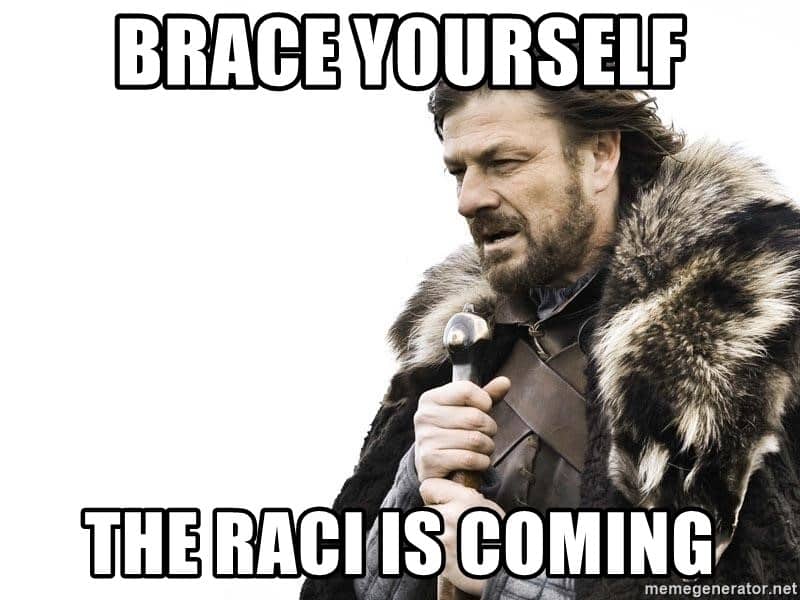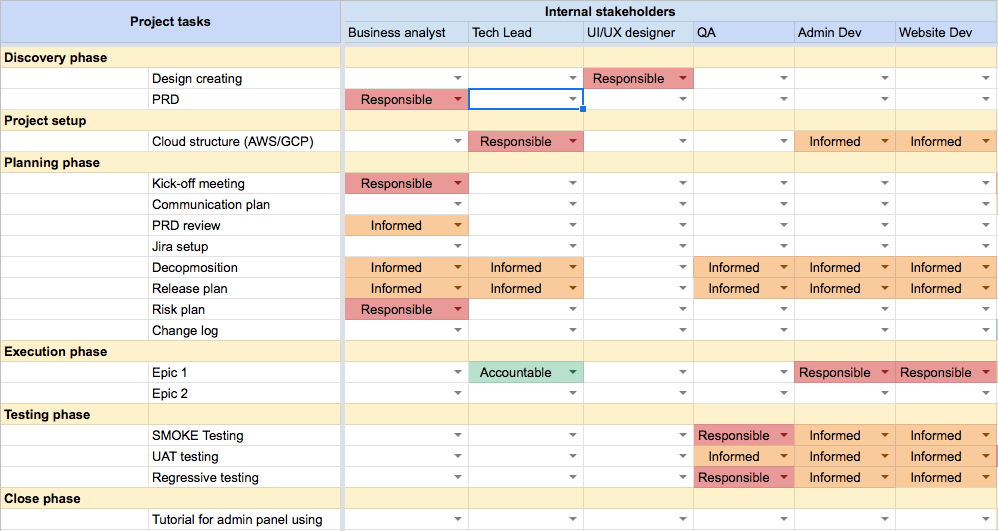RACI matrix in project management: what is it and how it can be useful
App development involves project managers, strategists, business consultants, designers, and assurance specialists. They have different roles and responsibilities. The RACI matrix is used to distribute and map duties and powers within a project.
Imagine that you organize a Birthday party for your buddy. Setting it up alone is complex, so you call for backup. Jane buys balloons, Carl and Ginger get groceries, Alex is responsible for drinks, Christina – for music, and so on. You discuss everything in a group chat, sum it up, and pin a message with a list of tasks and accountable on top. Everything seems adequately organized. There are big chances that the party goes smoothly.
Kind of the same happy end happens to the project management when you use the RACI matrix.

To get the idea better, let’s decipher the abbreviation that stands for the roles of the project:
- R – Responsible (executes);
- A – Accountable (checks out the result & carries responsibility);
- C – Consults before doing/execution (gives input before work is done, has an active role);
- I – Informs after doing/execution (needs information about project’s progress, decisions, has a passive role).
Sometimes you can also meet RACIS, where S stands for supported (assists/supports).
The RACI matrix has different forms and can be modified at your discretion. Usually, it’s a table with:
- tasks, responsibilities, procedures, expected results of the project located vertically;
- people or roles situated horizontally.
The RACI matrix definitions can still be blurry. So, let’s see how it works in practice with configuration and incident management processes. The activities within the project:
- introduction of a new category;
- delivery of information;
- reconciliation of discrepancies;
- updating information;
- audit;
- process improvement.
Some roles of the project:
- process owner;
- process manager;
- assistant manager;
- category CI owner.
The RACI matrix sample:
| Activity/ Role | Category CI owner | Assistant manager | Process Manager | Process Owner |
|---|---|---|---|---|
| Introduction of a new category | R | R | RA | C |
| Delivery of information | C | A | ||
| Reconciliation of discrepancies | C | R | RA | |
| Updating information | C | R | A | |
| Audit | R | R | RA | |
| Process improvement | C | C | RA | R |
Hence, let’s agree on a couple of rules when constructing the RACI matrix:
- There should be only one Accountable. If there are more, limit the scope, in which having only one Accountable is possible. You can choose an Accountable for this specific moment or these specific conditions. In other conditions and another moment, there can be another Accountable.
- Each activity should have an Accountable.
- Each movement should have a Responsible. There can be several of them.
- Not every activity needs to involve all stakeholders. Some C’s and I’s can be skipped.
In what cases is the RACI matrix a must-have?
The RACI matrix doesn’t substitute the project plan. It’s just a visual representation of the roles and responsibilities of the project. Hence, it simplifies and structures communication within the team and newcomers. It’s useful anyway but a must-have when:
- There are 2+ external stakeholders, multiple departments & outsourced staff. All of them need to be aligned with the processes and operations.
- There are changes in processes from the customer’s side (introduction of new stakeholders, changes in the team, etc.). Thus, no crucial functions or methods are missed.
- the project manager changes;
- There is a risk of confusion due to the fuzzy distribution of workload and responsibilities.
The RACI matrix is precious for complex projects. They consist of numerous milestones, deadlines, and iterations. The research shows a positive effect for such companies as eBay, Amazon, and the U.S. Department of Defense.
How can the RACI matrix be functional?
As said, the matrix simplifies and speeds up communication and feedback from the customer. Everyone is informed about other’s responsibilities and knows whom to reach out to.
It boosts the performance of the newbies. They clearly understand their scope of responsibility. According to research by Effectory, team members, who clearly understood their roles, were 53% more efficient than those who faced role ambiguity.
It gives clarity to the distribution of accountability between BA and PM. A project manager focuses on a project. A business analyst concentrates on the end product. Mixing these two different roles can compromise the quality of both the project and the end product.
The matrix increases the efficiency of demos. Everyone knows who needs to be informed. Hence, there are high chances that the report will come to the right place.
Besides, it improves the UAT process as deliverables identify responsible for the check.
It contributes to painless further development and future projects as potentially we know who to work with. For example, after getting Change requests, we understand from whom to get approval to make a double-check.
How to build the RACI matrix?
- Decompose the project into several stages.
- Decompose each step into milestones.
- Identify internal and external stakeholders & Distribute the project roles.
Decomposition of the project into smaller components has many advantages. It helps to make up an accurate plan with precise time, cost, and risk estimates. It contributes to understanding the scope and the changes in the area. Eventually, it helps to distribute roles. Write down the milestones/tasks vertically. Don’t go with too many tasks. Otherwise, the matrix will become too complex.
Think about who is involved in the project. Divide them into internal (team) and external (customer) stakeholders. Decide on the tasks they could be responsible, accountable for, consult, or just be informed.
Write down the roles or names horizontally.
Specifying people by name is better when several people fulfill similar roles. It will also give a better understanding of who is involved in the project.
Specifying the roles works better when the same person fulfills several functions. This way, you will also avoid confusion in case of changes in the team.
Then, agree on the matrix with your team members and key stakeholders.
RACI matrix template: Excel free file from Fulcrum Rocks
In all our projects, we use the RACI matrix. Through trial and error, we worked out a template that perfectly works in app development. It might also work for you. So, we gladly share our free RACI matrix template.
You will see how we divide the project into stages, the stages into milestones, how we distribute roles and responsibilities.



